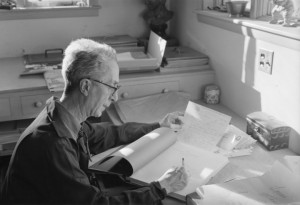
Norman Rockwell answering fan correspondence in his studio; Stockbridge, Massachusetts, c.1971. Photograph attributed to Louie Lamone. Norman Rockwell Museum Collections. © NRELC
STOCKBRIDGE — Norman Rockwell and his work are going viral.
After a decade of planning, scanning and digitizing, The Norman Rockwell Museum is launching ProjectNORMAN — the preservation, archiving and creation of a digital catalogue of Rockwell’s work — today for public use. Now researchers, students and art enthusiasts alike will have online access to the museum’s art and archival collection with the click of a mouse.
“I’m so excited to see it go live online,” said Laurie Norton Moffatt, the director and CEO of the Stockbridge-based Norman Rockwell Museum. “It’s going to transform the museum and access to Rockwell’s work from a global perspective.”
Described as a “labor of love” for the staff, ProjectNORMAN holds the museum’s more than 2,000 works, 20,000 reference photographs, images of more than 3,000 objects from Rockwell’s studio, and each of the 4,000 records and images from Rockwell’s catalogue raisonné, “Norman Rockwell: A Definitive Catalogue.”
Almost $2 million in foundation grants have been raised since 2003 to finance the project, which holds not only Rockwell’s work but also the American illustration art that’s part of the museum’s collection, according to Norton Moffatt.
Users can access the vast online catalogue by going to the museum’s website, www.nrm.org. Click “Browse the Collection” under the “Collections” tab on the top menu bar to get to the project’s home page. Because the work is not public domain, users will be asked to accept terms and conditions before entering the database, according to Corry Kanzenberg, curator of archival collections.
There is no cost to access the collection, but the images are watermarked — meaning the images can be easily viewed but have “Norman Rockwell” lightly written over them in medium-sized letters — and are presented in low resolution to prevent reproductions, Kanzenberg said.
In addition to basic and advanced searching capabilities, the database also hosts a “Highlights” section on the right side of the main page. That serves as a rotating online exhibition space with a topic or search created by curators for the user to browse — it’s like walking through a virtual museum.
Searches are not limited to the names of paintings. Users can search by title, artist, year or even the name of a particular model who posed for Rockwell’s paintings, Kanzenberg said. When the user clicks on an image, all reference photography — the images used by Rockwell to document the painting process or the pictures of the models he used for that particular work — will link to it. It also includes information about the work, detailed bibliography references, links to other work by the artist and the artist’s biographical information.
“If anyone has ever used an online collection from another museum, they will understand how to use this,” Kanzenberg said.
The two- and three-dimensional objects Rockwell used, such as his paintbrushes and the props for his paintings, were also photographed and catalogued.
In essence, it’s a type of one-stop museum browsing for art lovers of all backgrounds and capabilities.
“It’s accessible to people anywhere, anytime,” Norton Moffatt said.
Though the Norman Rockwell Museum is not the first to digitize its collection — locally, the Williams College of Museum of Art and The Sterling and Francine Clark Art Institute have digital catalogues of their collections — it is rare for a museum of its size to tackle a project this large and see it through to completion, Kanzenberg said.
The process of digitizing the collections was a complicated dance of scanning — some was done in-house, some outsourced for those collections that were either too big or were deteriorating faster than the staff could scan. Then, creating “finding aids” or detailed descriptions for each piece of the collection to make searching the archive easier was also a task.
“For a staff our size to have been able to wrap our arms around a project this size — it’s a model for the nation,” Norton Moffatt said. “There is a palpable feeling of excitement in the museum. We’ve achieved our dream of having the collection available worldwide.”
http://www.berkshireeagle.com/ci_17021361
Related articles:

